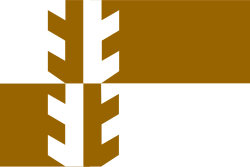This article needs additional citations for verification .(March 2011) |
Damaraland | |||||||||
|---|---|---|---|---|---|---|---|---|---|
| 1980–1989 | |||||||||
Flag | |||||||||
| Location of Damaraland (green) within South West Africa (grey) | |||||||||
 Map of the Bantustan | |||||||||
| Status | Bantustan Second-tier authority (1980–1989) | ||||||||
| Capital | Khorixas | ||||||||
| Common languages | Khoekhoe Herero English Afrikaans German | ||||||||
| History | |||||||||
• Self-government | 1980 | ||||||||
• Re-integrated into Namibia | May 1989 | ||||||||
| Currency | South African rand | ||||||||
| |||||||||

Damaraland was a name given to the north-central part of South West Africa, which later became Namibia, inhabited by the Damaras. It was bordered roughly by Ovamboland in the north, the Namib Desert in the west, the Kalahari Desert in the east, and the Windhoek region in the south.

